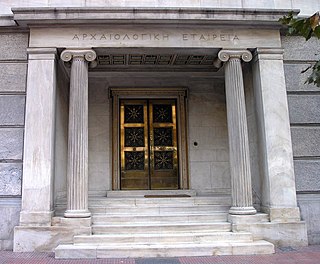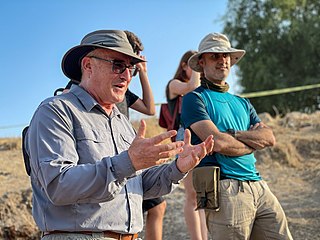Related Research Articles
Computational archaeology describes computer-based analytical methods for the study of long-term human behaviour and behavioural evolution. As with other sub-disciplines that have prefixed 'computational' to their name, the term is reserved for methods that could not realistically be performed without the aid of a computer.

Dorothy Annie Elizabeth Garrod, CBE, FBA was an English archaeologist who specialised in the Palaeolithic period. She held the position of Disney Professor of Archaeology at the University of Cambridge from 1939 to 1952, and was the first woman to hold a chair at either Oxford or Cambridge.

The Archaeological Society of Athens is an independent learned society. Also termed the Greek Archaeological Society, it was founded in 1837 by Konstantinos Bellios, just a few years after the establishment of the modern Greek State, with the aim of encouraging archaeological excavations, maintenance, care and exhibition of antiquities in Greece.
Philip Arthur Rahtz was a British archaeologist.

The Israel Exploration Society (IES), originally the Jewish Palestine Exploration Society, is a society devoted to historical, geographical and archaeological research of the Land of Israel. The society was founded in 1913 and again in 1920, with the object of studying the history and civilization of the Land of Israel and of disseminating its knowledge.

Aren Maeir is an American-born Israeli archaeologist and professor in the Department of Land of Israel Studies and Archaeology at Bar-Ilan University. He is director of the Tell es-Safi/Gath Archaeological Project.
Paul Reilly is a pioneer of virtual archaeology and data visualisation in archeology. He was a research scientist at the IBM UK Scientific Centre. He received his B.A. Honours degree in archaeology and history from the University of Leeds and his Ph.D. in computer-based archaeological research, at the Research Centre for Computer Archaeology in North Staffordshire Polytechnic. He has worked on many archaeological excavation and field survey projects in Britain and elsewhere in Europe. From 1986 to 1989 he was an IBM UK Scientific Centre Research Fellow and became Research Scientist in 1989.

Winifred Lamb was a British archaeologist, art historian, and museum curator who specialised in Greek, Roman, and Anatolian cultures and artefacts. The bulk of her career was spent as the honorary keeper (curator) of Greek antiquities at the University of Cambridge's Fitzwilliam Museum from 1920 to 1958, and the Fitzwilliam Museum states that she was a "generous benefactor ... raising the profile of the collections through groundbreaking research, acquisitions and publications."
Qal'at Bustra or Qalat Bustra is an archaeological site in Lebanon, close to the border of the Sheba Farms region of the Israeli-occupied Golan Heights, about 5 km ENE of Ghajar. It is situated on a peak of height 786m with a panoramic westward view. Qal'at Bustr is believed to be an ancient Roman sanctuary and was excavated by Israeli archaeologists. Remains found at the site include a farmhouse and temple dating from the Hellenistic and Roman period.
Archaeopress is an academic publisher specialising in archaeology, based in Oxford. The company publishes multiple series of books and academic journals, including Archaeopress Archaeology, Proceedings of the Seminar for Arabian Studies (PSAS), and Antiguo Oriente.
David Leslie Kennedy is an archaeologist and historian of the Roman Near East, with a focus on Aerial Archaeology, Roman landscape studies and the Roman military. He is Emeritus Professor and Senior Honorary Research Fellow in Roman Archaeology and History at the University of Western Australia.
Lindsay Allason-Jones, is a British archaeologist and museum professional specialising in Roman material culture, Hadrian's Wall, Roman Britain, and the presence and role of women in the Roman Empire. She is currently a visiting fellow at Newcastle University.
Edith Mary Wightman FSA was a British ancient historian and archaeologist. She was Assistant-Professor and then Professor at McMaster University (1969–1983). Wightman was best known for her studies Roman Trier and Gallia Belgica.

Sonia Chadwick Hawkes was a British archaeologist specialising in early Anglo-Saxon archaeology. She led excavations on Anglo-Saxon cemeteries at Finglesham in Kent and Worthy Park in Hampshire. She was described by fellow medieval archaeologist Paul Ashbee as a "discerning systematiser of the great array of Anglo-Saxon grave furnishings".

Martin Henig is a British archaeologist, ethicist, and Anglican clergyman. He is a senior member of Wolfson College, Oxford.

Dimitris Plantzos is a classical archaeologist and writer, Professor of Classical Archaeology at the National and Kapodistrian University of Athens. He specializes in Greek art and archaeology, archaeological theory, and contemporary and modern receptions of classical culture.
Jodie Lewis is a British archaeologist specialising in the study of prehistory. She is a lecturer at the University of Bradford. She was elected as a Fellow of the Society of Antiquaries of London in 2015. Before joining Bradford in 2022, Lewis lectured at the University of Wales, Bangor, the University of West of England, and the University of Worcester. She is a council member of The Prehistoric Society.
David Mullin is British archaeologist specialising in the study of prehistory. He has worked at the University of Worcester, Oxford Archaeology, and the University of Oxford.
Paul Thomas Bidwell was a British archaeologist specialising in Roman Britain, Roman pottery, Hadrian's Wall and the Roman army in Britain.
Birthe Kjølbye-Biddle was a Danish archaeologist specialising in early Christianity in Britain.
References
- 1 2 Hands, Anthony (1996). "The Origins of BAR". In Davison, David; Henig, Martin (eds.). British Archaeological Reports: Past, Present and Future: Proceedings of a Conference held in Oxford in June 1994 to mark the Twentieth Anniversary of BAR. Tempvs Reparatvm. p. 1.
- ↑ Rahtz, Philip (1996). "Excavation Reports and BAR". In Davison, David; Henig, Martin (eds.). British Archaeological Reports: Past, Present and Future: Proceedings of a Conference held in Oxford in June 1994 to mark the Twentieth Anniversary of BAR. Tempvs Reparatvm. pp. 16–18.
- 1 2 "About BAR Publishing". barpublishing.com. Retrieved 10 February 2020.
- ↑ "About Us". Archaeopress.com. Retrieved 9 October 2020.
- ↑ "Digital". barpublishing.com. Retrieved 10 February 2021.
- ↑ "International Series :: Domestic Multicrafting for Exchange at Prehispanic Ejutla, Oaxaca, Mexico". www.barpublishing.com. Retrieved 15 November 2024.
- ↑ Davison, David; Henig, Martin (1996). British Archaeological Reports: Past, Present, and Future: Proceedings of a Conference Held in Oxford in June 1994 to Mark the Twentieth Anniversary of BAR. British Archaeological Reports.
- ↑ Rowley, Trevor (1996). "BAR and the Adult Student". In Davison, David; Henig, Martin (eds.). British Archaeological Reports: Past, Present and Future: Proceedings of a Conference held in Oxford in June 1994 to mark the Twentieth Anniversary of BAR. Tempvs Reparatvm. pp. 19–20.
- ↑ Webster, Graham (1996). "The Past and Future of Archaeological Publishing in Britain". In Davison, David; Henig, Martin (eds.). British Archaeological Reports: Past, Present and Future: Proceedings of a Conference held in Oxford in June 1994 to mark the Twentieth Anniversary of BAR. Tempvs Reparatvm. pp. 5–6.
- ↑ Rahtz, Sebastian (1996). "BAR, Computers, and Publication: Past and Present". In Davison, David; Henig, Martin (eds.). British Archaeological Reports: Past, Present and Future: Proceedings of a Conference held in Oxford in June 1994 to mark the Twentieth Anniversary of BAR. Tempvs Reparatvm. pp. 10–15.